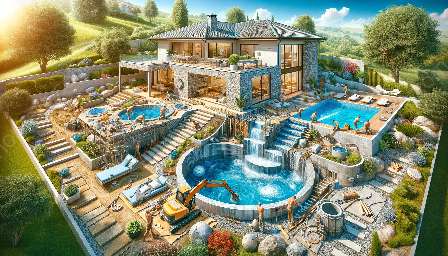Spa construction involves a detailed process that balances technical expertise with creative design to create a luxurious and relaxing environment. In this comprehensive guide, we will explore the various stages of building a spa, from initial planning and design to the installation of essential amenities such as swimming pools. Understanding the construction process of a spa is essential for anyone interested in creating a rejuvenating space that provides a perfect blend of tranquility and functionality.
Understanding the Technical Aspects
Before delving into the construction process, it is important to understand the technical aspects involved in building a spa. This includes considerations such as site preparation, drainage systems, water supply, electrical requirements, and compliance with building codes and regulations. The expertise of architects, engineers, and construction professionals is crucial in ensuring that the spa is built to the highest standards of quality and safety.
Design Considerations for Spa Construction
The design of a spa plays a pivotal role in creating an inviting and soothing environment. Architects and designers work closely with clients to understand their vision and preferences, taking into account factors such as landscaping, outdoor or indoor spa layout, structural design, and integration with existing structures or swimming pools. Attention to detail, use of quality materials, and adherence to aesthetic principles are integral to the success of the construction process.
Customization Options
One of the most exciting aspects of spa construction is the ability to customize various elements to reflect the unique style and personality of the owner. From selecting the type of spa - whether it is a traditional hot tub, an infinity pool, or a plunge pool - to choosing the interior finishes, lighting, and water features, there are countless customization options available. Innovative technology, such as automated controls, Wi-Fi connectivity, and energy-efficient systems, can also be integrated to enhance the spa experience.
The Key Steps in Building a Spa
1. Planning and Permits
The construction process begins with thorough planning, which includes acquiring necessary permits and approvals from local authorities. This stage involves detailed site surveys, assessment of soil conditions, and ensuring compliance with zoning and construction regulations.
2. Site Preparation
Site preparation involves clearing the area, leveling the ground, and ensuring proper drainage to create a stable foundation for the spa. The location and orientation of the spa are carefully determined to optimize views, sunlight exposure, and accessibility.
3. Construction of Structural Elements
The construction team then proceeds to build the structural elements of the spa, which may include foundations, retaining walls, decking, and outdoor enclosures. Attention is paid to the integration of plumbing, electrical, and mechanical systems during this phase.
4. Installation of Amenities
The installation of amenities such as the spa's shell, filtration and circulation systems, heating and ventilation, and lighting takes place at this stage. Specialized contractors and technicians work together to ensure that all components are assembled and integrated seamlessly.
5. Finishes and Landscaping
The final stages involve adding aesthetic touches such as tiling, decking, landscaping, and decorative elements to enhance the visual appeal of the spa. This is where the customization options chosen by the owner come to life, creating a cohesive and luxurious setting.
Integration with Swimming Pools
For many spa owners, the integration of the spa with an existing swimming pool or the construction of a new pool alongside the spa is a desirable feature. This involves careful planning to ensure a harmonious layout, shared amenities, and seamless connectivity between the spa and the pool. Collaboration between spa and pool construction professionals is essential to achieve a cohesive and complementary design.
By understanding the construction process of a spa and its integration with swimming pools, individuals can make informed decisions about creating a stunning and functional space for relaxation and rejuvenation. Whether for private residences, resorts, or wellness centers, the meticulous construction of a spa contributes to the overall ambiance and appeal of the environment.


